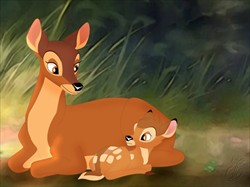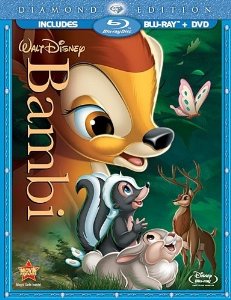 Do
mothers invest more care in their sons if they believe their child is
destined to be a king, president or a high-powered leader?
Do
mothers invest more care in their sons if they believe their child is
destined to be a king, president or a high-powered leader?The answer is definitively yes – as long as those mothers and their sons happen to have hooves.
New research from BYU reports that, just like the classic tale of Bambi, females from the deer family are more likely to invest more in the survival and health of their male offspring if there is a good chance those sons will become a “Great Prince of the Forest.”It always comes up when people are comparing their most traumatic movie experiences: “the death of Bambi’s mother,” a recollection that can bring a shudder to even the most jaded filmgoer.___That primal separation (which is no less stunning for happening off-screen) is the centerpiece of Bambi, Walt Disney’s 1942 animated classic, but it is by no means the only bold stroke in the film. In its swift but somehow leisurely 69 minutes, Bambi covers a year in the life of a young deer. But in a bigger way, it measures the life cycle itself, from birth to adulthood, from childhood’s freedom to grown-up responsibility. All of this is rendered in cheeky, fleet-footed style–the movie doesn’t lecture, or make you feel you’re being fed something that’s good for you. The animation is miraculous, a lush forest in which nature is a constantly unfolding miracle (even in a spectacular fire, or those dark moments when “man was in the forest”). There are probably easier animals to draw than a young deer, and the Disney animators set themselves a challenge with Bambi’s wobbly glide across an ice-covered lake, his spindly legs akimbo; but the sequence is effortless and charming. If Bambi himself is just a bit dull–such is the fate of an Everydeer–his rabbit sidekick Thumper and a skunk named Flower more than make up for it. Many of the early Disney features have their share of lyrical moments and universal truths, but Bambi is so simple, so pure, it’s almost transparent. You might borrow a phrase from Thumper and say it’s downright twitterpated. –Robert Horton___For the first time ever, the wonder, music and majesty of one of Walt Disney’s greatest triumphs comes alive in glorious detail through the magic of Blu-ray high definition! Now Bambi, Walt Disney’s beloved coming-of-age story, will thrill a new generation of fans with its breathtakingly beautiful animation, soaring music and characters who will touch your heart-Bambi, the wide-eyed fawn, his playful pal Thumper, the loveable skunk Flower and wise Friend Owl. Plus, all-new immersive game and special features that reveal the extraordinary creative process behind the making of this timeless classic take you deeper into Bambi’s world than ever before. Walt Disney’s Bambi is an experience you will never forget-now more brilliant than ever on Blu-ray.
___
“Our research demonstrates clearly that a mother’s investment in her offspring was evident during adulthood, even though offspring live independently of their mothers from a very young age,” said Brock McMillan, associate professor of wildlife ecology at BYU.
The comprehensive study of deer and elk from the Intermountain West found that the most dominant males at the time of death were those who were born into the most favorable maternal conditions 5 to 15 years before.
While favorable maternal conditions are largely tied to the health of the expectant mother, there are additional elements at play.
A mother’s investment happens both in the womb and during the first few months of life. During those early stages of life, mothers take care to provide more excellent nourishment through lactation as well as better habitats for the baby.
“Male deer and elk live independently of their mothers for several years in highly variable environments,” McMillan said. “They live through severe winters with deep snow and little to eat, dry summers with poor quality food and years of injuries and ailments associated with everyday life. Even with many years of exposure to the environment, the maternal effect was still evident.”
The study, appearing in the current issue of scientific journal PLOS ONE, provides new information for how deer and elk populations propagate.
Whereas deforestation, human-encroachment into natural habitats, increased predators, and several other factors have been thought to play the most prominent roles in determining deer and elk population trends, this study implies that an equally important factor is the health and nurturing of the mothers years before.
“For those unconcerned about deer or elk, this research can be a reminder that similar research exists for humans,” said student Eric Freeman, lead author on the study. “Conditions experienced in utero affect offspring throughout their life even in long-lived species.”

Comments